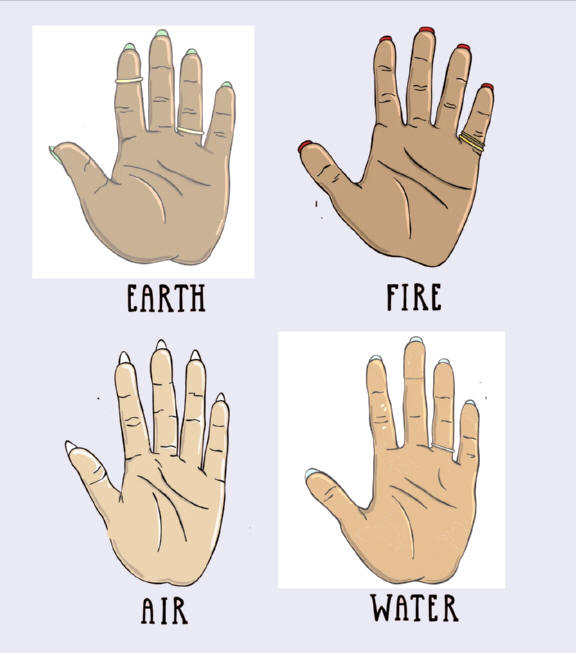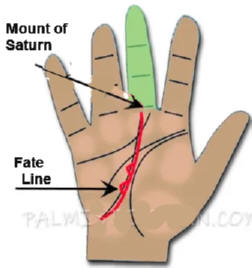|
t
|
| |
|
|
 Palmistry
Palmistry |
|
Palmistry,
also known as palm
reading, chiromancy,
or chirology,
is the
is the science and art of reading the hands to gain
information about the person. It is practice is found all
over the world, with numerous cultural variations. Those
who practice palmistry or chiromancy are |
 |
|
generally called palmists, hand readers,
hand analysts, or chirologists.
There are many and often conflicting interpretations of
various lines and palm features across various teachings of
palmistry. Palmistry is practiced by the Hindu Brahmins.
The contradic-tions between different interpretations, as well as
the lack of evidence for the acuracy of palmistry's predictions,
have caused palmistry to be viewed as a pseudo-science by
many.
After falling out of favor around
the Middle Ages, palmistry underwent a monumental revival in the 19th
century as interest in the occult grew. Palmistry societies were
founded to promote and
advance the practice.By the mid-1900s, palmistry was fully integrated
within American pop culture.
Reading Palms
Just
like learning astrology, palmistry takes time, practice, and expertise.
When beginning, it's best to start with larger observations and work
your way into more detail. Familiarizing yourself with traditional
interpretations can help you develop |
|
your own,
like a pro. Many
modern readers believe it's important to analyze both the
left and right hands: The non-dominant hand reveals natural personality
and character, while the dominant hand shows how these traits
have been actualized in practice. Together, they reveal how a person
is utilizing their potential in this lifetimTo get
started, take your time to make a few silent observations with the
querent's hand cupped in your own. What is the texture? Is the front
smooth while the palm is rough? Are the fingers well manicured or
not? Everything has meaning, and when you infuse your practice with
intuition, you'll soon be able to extract the meaning of the
smallest details.
Next,
familiarize yourself with the hand shapes that correspond with the four
elements: fire, earth, air, and water. After mastering hand
shapes and their associated elements, you can get to know the mounts and plains of
the hand, regions that correspond with major areas of life, as well
as the lines and
creases that tell a story about the future. Let's take a look at
each of these.
|
 |
|
There are four basic hand shapes within palmistry, each connected with a
different element — fire, water, earth, and air — and its associated
traits. Although the four elements are also embedded
in astrology, your hand type may not correspond with your
astrological profile. For instance, while your sun sign might be Aries (a
fire sign), the shape of your hand may be that of a water sign,
revealing nuanced insight into the complexities of your personality.
Earth hands are
identified by square palms and short fingers. These hands are often
firm, solid, and fleshy. Individuals with earth hands are known to be
practical, logical, and grounded. While secure and reliable, they can
become too consumed with their immediate realities, which can ultimately
hinder long-term planning and achievement.
A Fire hand
is recognized by its long
palm and short fingers. These hands often have distinctive creases and
defined mounds (read on for more about those).
|
Individuals with fire hands are known
to be passionate,
confident, and industri-ous. They're driven by their desires and on a bad day they may lack
tactfulness and empathy. They're driven by their desires and on a
bad day they may lack tactfulness and empathy.
Air hands
have square palms and long fingers and are
often boney, with protruding knuckles and spindly fingers. This hand
typesignifies
intellectually curious individuals with innate analytical abilities and communication skills. Those with air
hands are easily distracted and, if not stimulated, can become anxious
or edgy.
Water hands
are distinguished by their long palms and
long fingers. These hands are often soft to the touch and a bit clammy,
with an overall narrow appearance. Those who have them are in tune with
their emotions, intuition, and psychic ability. Fueled by compassion and
imagination, these individuals are often creatives. They're also
extremely sensitive and their feelings are easily hurt, causing
undesirable interpersonal
stress.
|

The Mount of Saturn is located at the base of the middle finger. This
area corresponds to wisdom, responsibility, and fortitude. It reveals an
individual's integrity, as well as their deep understanding of the ups
and downs of life. |
|
Mounts and plains
After you've identified the hand type, begin observing the palm's
natural topography. Fleshy areas called mounts are
related to different life themes. The classic mounts correspond with the
seven planets within astrology: Apollo (the sun), Luna (the moon),
Mercury, Venus, Mars, Jupiter, and Saturn. Rounded, slightly elevated
mounts reveal attributes that are balanced and well-proportioned, while
sunken mounts expose an individual's "blind spots" or under-developed
qualities. Lastly, extremely prominent mounts reveal dominant
characteristics that may be exaggerated or overemphasized.
The Mount of Jupiter
is
located at the base of the index finger (and above the Mount of Inner
Mars), the Mount of Jupiter symbolizes confidence, ambition, and
leadership. It reveals a connection to the spiritual realm, along with
divine aptitudes.
What is
the Mount of Apollo?
Situated beneath the ring finger, the Mount of Apollo derives its name
from the sun god of classical antiquity. Within palmistry, this area of
the hand correspondswith an individual's optimism, vitality, and dynamic
essence. Just as as zodiac
sun signs expose
|
an individuals' innate identity, the
Mount of Apollo showcases artistic inclinations, happiness, and
potential for success.
What is
the Mount of Mercury?
Below the pinky finger, the Mount of Mercury is connected to
communication and intelligence. This region is linked to wit,
adaptability, and social skills, revealing an individual's strategic
mind and resourcefulness.
What is
the Mount of Luna?
Named after the ancient Roman goddess who personified
the moon, the Mount of Luna symbolizes imagination, intuition, and
psychic powers. Located toward the bottom of the palm on the pinky side,
this area reveals an individual's empathy, compassion, and imagination.
What is
the Mount of Venus?
Located at the base of the thumb, the Mount of Venus is linked to love, sensuality,
and attraction. This zone showcases natural magnetism, as well as an
individual's emotional
connection to romance. Sexuality, passion,and
indulgence are all under the auspices of this region.
|


